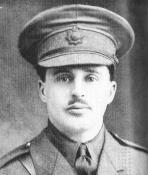
War Memorial
| Captain Cecil Francis Harvey TWINING | |
|
3rd Battalion Hampshire Regiment attached to A Company, 1st Battalion Date of birth: 2nd August 1885 Date of death: 3rd May 1915 Killed in action aged 29 Commemorated commemorated on the Menin Gate Panel 35 |

|
| Cecil Francis Harvey Twining was born at 7 Stanhope Street, Hyde Park London on the 2nd of August 1885 the eldest son of Herbert Haynes Twining, a banker, and Louisa “Lulu” Caroline (nee Keating) Twining of 48 Ennismore Gardens, Knightsbridge in West London. He was educated at Hazelwood School until July 1899 where he was a member of the Choir and was a member of the Football XI in 1897 and 1898. The school magazine wrote of his 1897 football season: - "(Outside right) - Is improving very fast, has a grand turn of speed which he is beginning to make more use of than he did at first, and centres well, but is an uncertain shot. " Of his 1898 football season they wrote: - "Outside right, also wants a little more skill in dribbling to become first rate, not very nimble at taking a pass but centres and shoots well." He was a member of the Cricket XI in 1898 and 1899 when the school magazine noted the following on his 1898 season: - "Has a nice forward play useful to fast bowling, but has no idea of waiting for and timing a slow or short ball, and treats crooked stuff with undue respect. A fast but uncertain field." Of his 1899 season they wrote: - "A very bad starter, but if he survives a few overs is a merry hitter. Neat in the field, but hardly safe. his bowling did not improve as much as we hoped." On leaving the school the magazine wrote: - "Ought to be heard of at Eton in the football field and the running path. His cricket will want a lot of watchful care to be useful. He has been of great service in the choir and on the stage." He went on to Eton College where he was in Mr W.F.H. Tatham’s house from January 1900 to 1903. He was a member of various cricket clubs, including the M.C.C., Free Foresters, Eton Ramblers, Butterflies and Hampshire Hogs. He was also a member of the Conservative and Prince’s Clubs and of Stoke Poges and East Brighton Golf Clubs. In August 1909 he joined his father’s firm, Lloyds Bank in the Law Courts Branch, 222 the Strand. He was a trustee of the London Penitentiary, Highgate and a member of the Amicable Society of St Clement Danes. He was married to Dorethea Elizabeth (nee Charrington) on the 6th of April 1910 at St Clement Danes Church in the Strand and they honeymooned in Holland. She remarried twice after his death becoming Mrs Mackenzie in 1917 and later Mrs Bonham-Christie. They lived at 21 Basil Mansions, London SW. He was commissioned as 2nd Lieutenant in the 3rd Battalion Hampshire Regiment (Militia) on the 30th of April 1904 and was promoted to Lieutenant on the 17th of November 1908. On the outbreak of war he was stationed at Parkhurst Barracks on the Isle of Wight. He was promoted to Captain on the 9th of September 1914 and was attached to the 1st Battalion for active service, embarking for France on the 12th of September 1914 and joined them in late September on the Aisne as a replacement in charge of a draft of 266 men. During October he was sent out at night to obtain some information, which he managed successfully and was thanked by his Brigadier General. On another occasion he was ordered to advance up a railway line but came under machine gun fire from a German position. He led his men in a successful attack on the enemy barricade. He was wounded twice by a gunshot in the left arm in a night attack at Messines on the 1st of November 1914 and fell into a pit on top of a German sniper. He was evacuated from the front line and was taken to the Casino Hospital at Boulogne from where he was evacuated to England on the 5th of November, landing there the following day. He was later sent to Dublin but rejoined his battalion on the 29th of March 1915. By the 1st of May 1915 the Second Battle of Ypres had been raging for nearly a week. At this time the 1st Battalion Hampshire Regiment was in an exposed front line position between Berlin Wood and the village of St Julien. It was decided to withdraw the battalion from these trenches to a more defensible line further back. The 1st and 2nd of May saw intense shellfire on the Hampshire positions and at 9pm on the night of the 2nd of May they withdrew to bivouacs two miles to the southwest of Elverdinge. The German artillery followed them there and on the 3rd of May 40 more men became casualties including Cecil Twining who was killed. His wife received the following telegram dated the 23rd of May 1915: - "Deeply regret to inform you that Capt. C.F.H. Twining Hampshire Regt. was killed in action on May 3rd. Lord Kitchener expresses his sympathy." A brother officer wrote of him:- “His death was a great shock to all of us in the company, as he was loved by officers and men alike. The men of his company were very fond of him and would have followed him anywhere; his thought was always for their safety, and I don’t think he paid enough attention to his own.” The Eton Chronicle wrote: - "He was in every respect a fine officer, never sparing himself, and so one more name has to be added to the gallant list of old Etonians who have laid down their lives in the service of their King and Country." He was buried along with four other officers and a large number of men some four miles to the north east of Ypres, about a mile from Zonnebeke but the site was lost during the subsequent fighting. "They all lie in a very pretty field behind a farm house with crosses, but we only had time to nark Cecil's grave with a bottle and his names and regiment inside it." He is commemorated on the war memorial at Private Banks Cricket and Athletic Club in Catford and on the Marylebone Cricket Club memorial at Lords. |
|
| Went on to Eton College |
Back